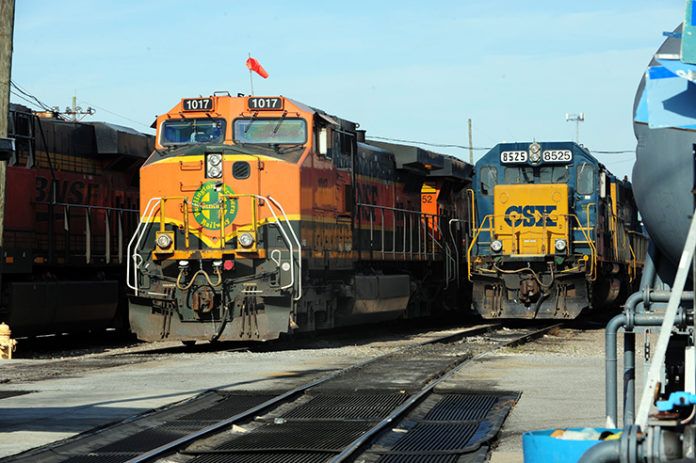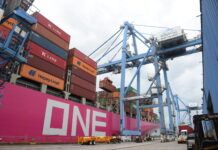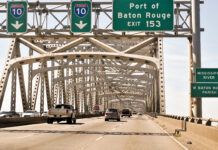For 109 years the New Orleans Public Belt Railroad has served as a catalyst for regional economic development by connecting the Port of New Orleans with railroad services. Since beginning operations in 1908, the NOPB has had a primary mission of serving both the port and local industries.
Owned by the city of New Orleans and a designated political subdivision of the state of Louisiana, the NOPB—a short-line Class III switching railroad—operates as a separate, neutral and financially independent entity. The NOPB plays a vital role in not only the local and regional economies, but in the national and global economies, as well. Rail traffic volumes have increased with global trade, and the NOPB is an important link in expediting local and intermediating freight through the strategic New Orleans rail gateway. New Orleans is one of four gateways connecting the eastern and western United States with six Class I railroads: BNSF, Union Pacific, Canadian National, Kansas City Southern, CSXT and Norfolk Southern. (Railroad class is based on revenue.)
In addition to the six Class I railroads that directly connect with the Public Belt, the NOPB also has a strong local customer base, largely resulting from demand driven by companies located on Port of New Orleans property. Examples include Ceres Gulf Inc., Destination Truck and Rail, Pacorini Metals USA, and U.S. Gypsum Co.
Yet despite the NOPB’s well-established history in the region, few residents are aware that the city of New Orleans actually owns a railroad. This was the case when New Orleans Mayor Mitch Landrieu and his administration took office in 2010.
“When we came in office in 2010, the Public Belt was embroiled in a scandal,” says Ryan Berni, the city of New Orleans’ deputy mayor of external affairs. “We were kind of surprised to learn the city even owned a railroad.”
It’s understandable that the city-owned railroad was not high on people’s radar. The Public Belt takes no tax money, but also contributes nothing to tax revenue. This piqued the mayor’s interest.
“The Public Belt is one of the only city assets that doesn’t have a direct financial relationship with the city,” says Berni. “The Public Belt is greatly undercapitalized. Given the global dynamics around private infrastructure, there is an opportunity to improve and enhance the railroad’s economic relationship with the city, the port and its customers.”
EVALUATING THE ASSET

The city hired consulting firm KPMG to evaluate possible options for the NOPB, including maintaining the status quo, selling the NOPB outright, and entering into a long-term public-private partnership in which a private operator would run and maintain the Public Belt. In April 2016 KPMG determined the valuation of NOPB’s assets was between $61 million and $196 million.
Ultimately, the city opted to pursue a public-private-partnership approach, which would “keep the city and port competitive and neutral, while having a private capital partner grow business and increase efficiency and safety,” Berni says. The city opted not to sell the NOPB outright, in part, because of potential risks to the local customer base from removing the Public Belt from public governance.
“We looked at the pros and cons of all three options,” Berni says. “We wanted an option that would allow us to better make strategic investment, allow for the efficient movement of freight, have the best economic impact, particularly on jobs, increase the financial stability of the railroad and have a great increase in tax revenue. And, the option would have to work for the citizens of New Orleans, who are the owners, as well as the port and customers.”
The city’s objectives include increasing the amount of tax revenue generated for the city by increasing business activity with the Public Belt and the port; growing the comprehensive NOPB business and being a complementary partner to grow cargo at the port; increasing economic activity throughout Orleans Parish and the New Orleans region, including job growth; and retaining and growing the existing labor pool through higher volume/rail throughput.
LOOKING FOR A PARTNER

In January the city issued a nonbinding request for qualifications (RFQ) for a private partner to take over operations, capital improvements, maintenance and carrier responsibilities of the NOPB’s core rail operating assets for 40 years. The private operator would be responsible for capital improvements and maintenance.
The lease includes the Huey P. Long Bridge over the Mississippi River. The city would retain ownership of the NOPB. The city is seeking at least $20 million in upfront payments and at least $1 million in annual lease payments over the 40-year period, resulting in at least $60 million for city coffers.
Five ventures responded, and the city now is in the process of reviewing the submissions. Up to five will be shortlisted and invited to submit final, binding proposals. The city expects the process of selecting a preferred respondent to be complete by mid-summer.
From the city’s perspective, entering into a public-private partnership provides an opportunity to not only bring in revenue from the long-term lease, but also to bring in funding for critical capital projects and maintenance activities that would increase not only throughput, but also competitiveness and safety of the NOPB.
Yet the city faces strong opposition to its plans for entering into a long-term lease with a private operator. The NOPB and its users, the Port of New Orleans, the Board of Trade, the Louisiana Railroad Association and the Greater New Orleans AFL-CIO have expressed opposition to the idea of leasing operational authority of the Public Belt to a private third-party corporation.
They argue the move could actually make the Port of New Orleans less competitive and, ultimately, hurt the local and regional economies. Greater New Orleans Inc., a regional economic development alliance that serves the 10-parish region in southeast Louisiana, is neutral on the Public Belt issue, according to Caitlin S. Berni, vice president for policy and communications, who is married to Deputy Mayor Ryan Berni.
“We were not set up to be a revenue generator for the city,” says Doug Campbell, NOPB’s interim CEO. “We were set up to help the city and the port grow. There’s concern that a private group would come in that is driven by profit. The question we ask ourselves is, ‘What’s best for the port, the city and the growth of this area?’ That’s what drives us. It’s not, ‘How can we make $10 million this year?’ If the city gets a bid for $20 million or $1 million a year for the next 40 years, is that life-changing for a city the size of New Orleans?”
THE PROFIT MOTIVE

As a public entity, the NOPB is tax-exempt, and the Port of New Orleans does not charge the NOPB rent for using port-owned properties.
The primary argument against the proposal to lease operation of the Public Belt is that a for-profit operator would raise rates or decrease service.
“We fear a private operator would come in and immediately raise rates,” says Brett Bourgeois, executive director of the New Orleans Board of Trade. “The cargo our users represent is very price-sensitive. If the price increases, they will go look for other ports.”
Brandy Christian, president and CEO of the Port of New Orleans, says the current rates are “reasonable and manageable.”
“The port is very satisfied with the current model and service—we’re not calling for any change,” she says. “Introducing a private profit motive into the rate structure will necessarily raise the current rates. That raises the specter of a loss of competitiveness for the port and its customers. We operate in a very competitive business and the [importance of the] Public Belt cannot be overstated.”
Bourgeois adds that a private operator could reduce the level of service to port users. “This would affect getting from point A to point B in a timely manner, so then we’re dealing with a time issue,” he says. “The Public Belt is a very important cog in the wheel that makes everything run.”
Those who oppose leasing the railroad’s operations also express concern about preferential treatment for some users. They stress that maintaining an independent, neutral entity is essential.
“The Public Belt is a neutral entity that has no favoritism to any of the railroads—all carriers are treated the same,” says Carmack M. Blackmon, general counsel and legislative representative with the Louisiana Railroads Association. “All six Class I’s that operate in New Orleans and utilize the Public Belt have advised city officials that they prefer to retain the status quo. They are not interested in a third-party, for-profit operator.”
THE CHOKE POINT

Blackmon adds that when one or two railroads get higher priority over the movement of freight, traffic starts to back up, which affects the bottom line for the railroads. In turn, there could be ramifications for the regional economy.
Tiger Hammond, president of the GNO AFL-CIO, elaborates on this.
“Privatizing operation of the NOPB would reduce port competitiveness by increasing the cost of business once the privatized railroad exploits the natural rail-to-port choke point, forming a de facto monopoly,” he says. “If the economic pressures inherent in the port’s choke point are not balanced by thoughtful government public action, then the city of New Orleans will lose some of its natural competitive advantages in the global marketplace.”
Christian notes this neutrality is a founding principle of the NOPB. “The railroad was established as an independent, neutral party to ensure the provision of equitable and competitive switching service to the port’s facilities, customers and industries,” she says. “This independent role is still needed to ensure that the Class I railroads do not use rate-setting and service practices to gain a competitive advantage.”
The Port of New Orleans, which has invested more than $100 million in capital improvement projects since 2012, including the $25 million Mississippi River Intermodal Rail Terminal, has experienced consistent growth in recent years, Christian says. But she adds that the port has experienced somewhat of a “chilling effect on business because of the uncertainty” surrounding the Public Belt’s future operational structure, with several port tenants already expressing concerns about changes to the railroad’s operations.
“The Class I’s are trying to make decisions about introducing services, and their business model is based on existing rates. For now, they are not spending capital,” Christian says.
However, according to Berni, “A lot of uncertainty has been because of attempts to stop or delay this process, especially early on. Once we got to this point, I think we’ve moved pretty swiftly.”
Additional concerns include that a private operator could develop its own infrastructure, such as warehouses or a transload facility, nearby and compete with port customers. Also, all NOPB employees, except for management, are unionized. The NOPB has 180 employees.
A GROWTH OPPORTUNITY

One reason that the port and its stakeholders, local industry leaders and local labor associations support maintaining the current operational model is, they say, because concerns they had with the NOPB and its commission were addressed in 2011. After a state legislative audit, the NOPB underwent significant changes, including the resignation of the then-general manager. At the time, the idea of selling the NOPB was suggested. Instead officials instituted management and organizational changes supported by the Port of New Orleans, the Board of Trade and the NOPB itself. Those changes vastly enhanced the Public Belt’s operations, they say.
“The Public Belt is running better than in recent memory,” says Campbell, NOPB’s interim CEO. “The Public Belt is an efficiently run railroad and we’re creating partnerships in the right way. Customers are coming to us and asking what else we can do for them. That’s almost unheard of in railroads.”
Instead of privatizing operations, Campbell and others say, the status quo should be maintained, with a focus on options to grow the railroad and add capacity that the NOPB has identified, such as expanding the railroad’s operations into St. Charles and St. Bernard parishes, as well as expanding France Yard to accommodate expected customer growth in New Orleans East.
After the city selects a preferred respondent this summer, any long-term lease agreement with a private, third-party operator will have to be recommended by the NOPB’s commission and then forwarded to the City Council for approval.
“It’s a very complicated, technical issue and there are a lot of hurdles and a lot of players,” Christian says. “It’s more than just a New Orleans issue—it’s a regional and national issue, as well.”
Berni agrees, even if the city has a different perspective from other stakeholders.
“If we look at what drives discussions in the 10/12 corridor, there’s port expansion, increased trade opportunities and a lot of opportunity for growth,” he says. “We’ve got a unique situation because of the six Class I’s and we’ve got an opportunity to make a strategic decision regarding investment in this asset (the Public Belt) for the region, including customers and taxpayers.”
This article was originally published in the second quarter 2017 edition of 10/12 Industry Report.









